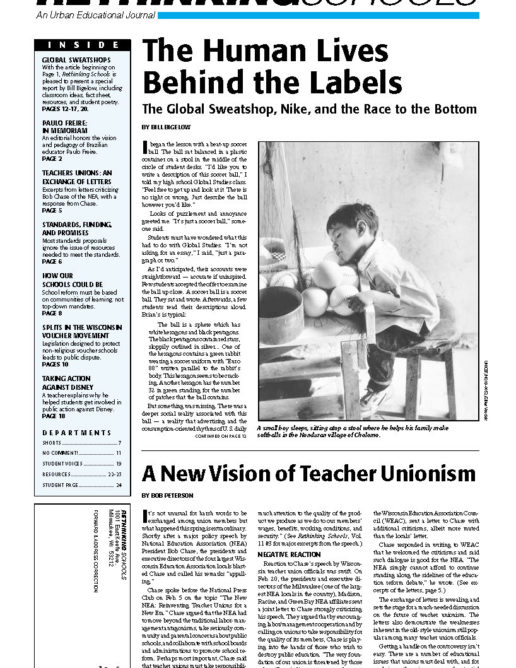Facts on the Global Sweatshop
SWEATSHOP DEFINITION:
Any workplace where the wages are inadequate, the hours too long, and the working conditions endanger safety or health — whether or not any laws are violated. (Pharis Harvey, Executive Director, International Labor Rights Fund)
- Haitian workers earn only 6 cents for every pair of Disney “101 Dalmatians” outfit that Disney sells for $20. Disney pays its workers in Haiti about 28 cents an hour. A Salvadoran woman working in a sweatshop makes 12 cents sewing a GAP t-shirt that sells in the U.S. for $20. (Sources: In These Times; National Labor Committee; Jobs with Justice)
- Almost half of all toys sold in the U.S. are produced in China, Thailand, and other Asian countries. “China is the champ in the low wage sweepstakes. With minimum wages that hover around 80 cents a day, China is forcing a further decline in the already hideous working conditions in neighboring countries. Naturally, Western executives are flocking to China to do business.” (Bob Herbert, The New York Times)
- In 1995, Mattel C.E.O. John Amerman made $7 million and held an additional $23 million in stock options — more than the combined annual salary of the 11,000 Mattel workers making Barbie dolls in China. (Eyal Press, The Nation)
- There are sweatshops in the U.S., too. One worker at a Los Angeles garment factory making clothes for Guess was paid 40 cents for his labor on a blouse that sold in a New York department store for $58. (Source: American Teacher)
- Myth: It’s OK to pay workers in poor countries lots less than workers are paid here because living expenses are so much less. Milk: in Haiti, 75 cents; in NY, 65 cents; eggs: in Haiti, $1.50; in NY, $1.39; cereal: in Haiti, $1.90; in NY $1.69; gas: in Haiti $2.20; in NY, $1.26. (Source: Newsday)
- In Indonesia, the minimum wage is $2.36 per day. The Suharto dictatorship admits that in Jakarta and other urban centers it takes $4 a day to meet subsistence needs. If Nike took just 1% of its annual advertising budget ($280 million), it could raise the income of all its Indonesian workers above the poverty line. (Source: Counter Punch, Global Exchange)
- Almost all soccer balls used in the U.S. are imported. Major soccer ball manufacturing countries: Pakistan, China, and Indonesia. Between 1985 and 1995, the soccer ball industry greatly increased production in countries where children make leather hand-stitched balls. In countries like Pakistan, children may work 12 -hour days for very little pay. (Source: International Labor Rights Fund)
- Nike CEO Phil Knight is the sixth richest man in the United States. He owns 100 million shares of Nike stock. His dividend income alone for the third quarter of 1996 was $80 million dollars. More than 75% of Nike’s shoe production occurs in countries where it is illegal to form independent trade unions. (Source: Counter Punch, Press for Change)
- Throughout the world, 250 million 5 to 14 year olds are employed; one half of these work full-time. Many children work in industries where they are exposed to harmful chemicals or other dangerous conditions. In Sri Lanka, more children die from pesticide poisoning than from a combination of childhood diseases including malaria, tetanus and whooping cough. (Source: International Labor Organization)
ON THE OTHER HAND
- 75% of U.S. consumers say they would boycott stores selling goods from sweatshops, and 85% say they would be willing to pay 5% more for legally made products. (Source: Marymount University)
- The Bonded Labor Liberation Front in Pakistan has opened 240 free primary schools for poor children. Since 1980, the South Asian Coalition on Child Servitude has freed over 29,000 children from forced labor. (Source: Sydney Schanberg, Life)
- At the end of April 1997, 10,000 workers went on strike at a Nike factory in Indonesia, despite the fact that free trade unions are banned there. During the same week, 1,300 workers went on strike at a Nike factory in Vietnam, and workers there have staged dozens of wildcat strikes protesting low pay and abusive working conditions over the last few years.. (Source: Associated Press, Far Eastern Economic Review)
- Students from Monroe High School in Los Angeles organized to get a resolution passed by the school board committing the district not to buy soccer balls from countries that allow child labor. Students in LA have formed Students Against Kid Exploitation. (Source: LATimes)
- On April 13, 1997, the largest, most diverse farmworker demonstration in history, including 20,000 people, was held in Watsonville, Cal. It was part of a United Farmworkers union drive to organize strawberry workers who labor in “sweatshops in the fields” for an average of $8,000 a year. (Source: The Nation)
- In February, North Olmsted, Ohio (pop. 35,000), a working class suburb of Cleveland, became the first U.S. city to ban municipal purchases of sweatshop-made products. It also covers U.S. sweatshops and allows no exceptions. The city is aggressively enforcing the new law. Says Mayor Ed Boyle, who thought up the law, “Government should not be party to the exploitation of children and adults anywhere in the world.” (Source: The Progressive)

